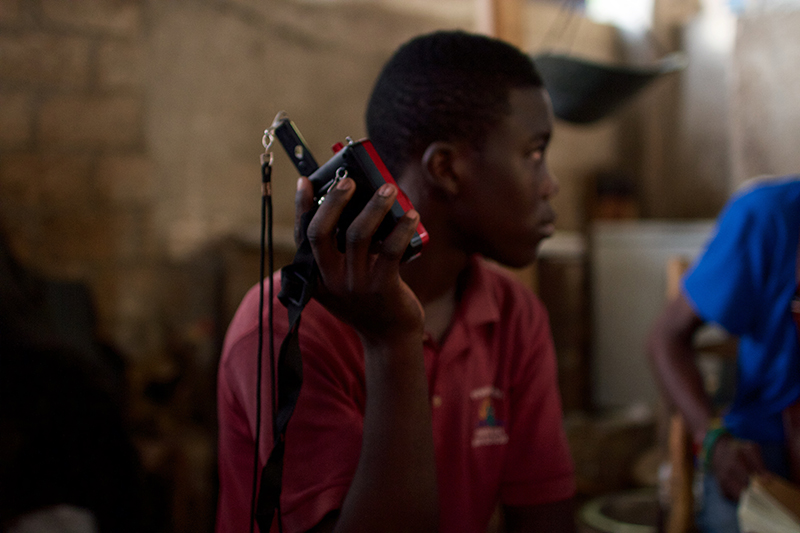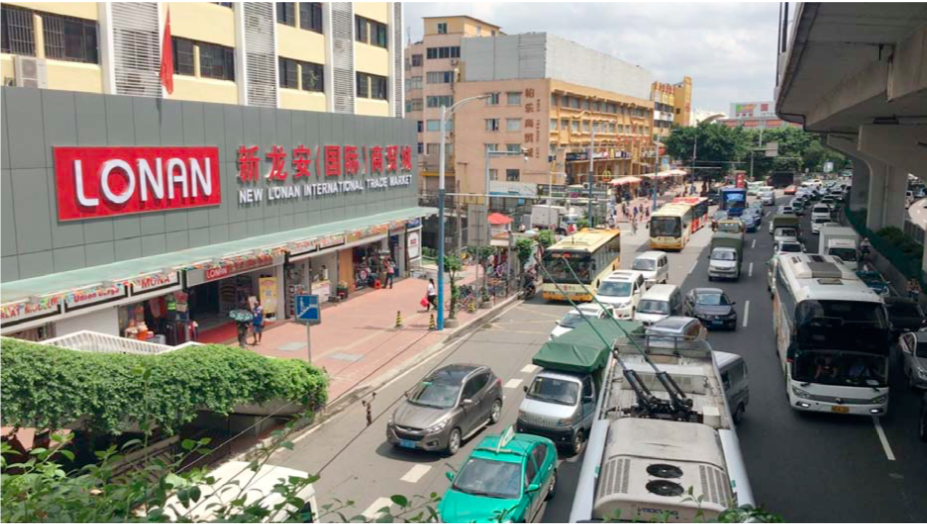
© » KADIST
Thiago Honório
Pau-Brasil is a sculpture by Thiago Honório that references Oswald de Andrade’s 1925 classic of Brazilian modernist literature of the same title. De Andrade’s work demands the resuscitation of “Brazilian” language and culture, advocating for the cultivation of invention and an illogical, “agile and candid” attitude. In response, Honorio’s work takes the physical form of a laquered stalk of the pau brasil tree, from which de Andrade’s work drew its title, piercing the physical form of the book itself.

© » KADIST
Li Jinghu
Benefiting from its geographic proximity to Hong Kong, since the 1980s Dongguan has become the factory of the world, with toys, plastic products and clothing as the major industries in the town. During its heyday, the region produced 50% of the world’s manufactured toys, but since 2008, the toy industry has declined as the factories moved to South East Asia. Archaeology of the Present (Dongguan) No.

© » KADIST
Guan Xiao
David is a five-minute pseudo music video that features an upbeat melodic soundtrack with a duet by the artist Guan Xiao and frequent collaborator (and KADIST collection) artist Yu Honglei. Three screens display a collection of home videos filmed and uploaded by tourists at the Galleria dell’Accademia in Florence capturing Michelangelo’s eponymous masterpiece. The mass popularity and commodification of this artwork is further exaggerated with the numerous forms that we encounter and consume the image or likeness of the sculpture in our daily lives.

© » KADIST
Adrían Balseca
Adrian Balseca’s Suspensión I inverts the logic of the old colonial game, the greasy pole. Digitally filmed in the Province of Morona Santiago among the last existing community at the entrance of the Sangay National Park, a native girl climbs a balsa tree trunk from which plastic containers filled with “local” fossil fuels hang (super, extra, eco-país, gasoline, diesel, etc.). The trunk – which is lightweight quality wood, typical of the subtropical jungle of Ecuador -– has been cut down and suspended vertically and the trophies of modern progress hang from it.

© » KADIST
Adrían Balseca
The project Grabador Fantasma (Phantom Recorder) consists of a communally constructed technological device in Sarayaku ancestral territory. Adrian Balseca’s site-specific composition is an “ecología del paisaje sonoro”, an artifact that collects sounds produced by different organisms, amplifying the complex historical plot of the area. From a traditional Sarayaku Peracian Dacryodes Copal wood barge with a solar cell panel system, an electric motor, a gramophone, and a recording system wireless audio, the specific characteristics of the soundscape are registered and transformed.

© » KADIST
Frédéric Nauczyciel
This early photographic work by Fre?de?ric Nauczyciel, titled Untitled (Boîte à prière, Istanbul, Novembre 2005) , features a young man in religious attire reading a religious text from inside a glass prayer box. Seemingly truncated by the shadows cast upon his seated position, the man is dramatically illuminated by a white neon light above. The harsh synthetic light reflects off of the man’s white robe and the glass box to create a haunting, artificial glow.

© » KADIST
Bili Bidjocka
The short two-channel video Pause/Tanmpo takes its cue from a coincidental encounter artist Bili Bidjocka had in Dakar. Walking down the corniche, he saw a boxer, a Senefalese man, training at the beach. It immediately reminded the artist of Le Boxeur—the most well-known brand of matchsticks in Cameroon.

© » KADIST
Allora & Calzadilla
This installation combines the display of real objects with the deceptively painterly amalgamation of their content as the subject of a photograph. Here Allora & Calzadilla condemn the worldwide threat of violence caused by the high desirability of oil and water. Caught in the light, the patterning of the two liquids in the print creates attractive rainbow-like pools, a distanced comment on pollution.

© » KADIST
Yoshinori Niwa
Yoshinori Niwa’s investigation into the monetary system and material goods is witnessed across a range of his works. As the title of this work indicates, Niwa visits several currency exchanges in the market in Istanbul and proceeds to continually exchange from one currency into another until he has no money left, going against the grain of the economy. The laborious act of exchanging the currency back and forth does not create any profit.

© » KADIST
Beatriz Santiago Muñoz
Marché Salomon by Beatriz Santiago Muñoz depicts two meat vendors, a young man and woman, chatting in Marché Salomon, a busy Port-au-Prince market. Amongst the surrounding bustle, the two have an unsentimental discussion about the mystical qualities of common products sold at the market, wondering whether the divine can inhabit any kind of object—mass produced bottles, toxic rivers, beheaded goats. Their musings weave together the cosmic and the mundane, with the work of butchering a goat and the characters of the market serving as existential metaphors for the universe, time travel, ghosts, and death.

© » KADIST
Danielle Dean
Hexafluorosilicic acid is a type of sodium fluoride waste product that can be found in a large amount of widely available products such as cleaning fluids, toothpaste, rat poison, and drinking water. In Danielle Dean’s video Hexafluorosilicic , she mulls on this substance and its troubling co-option by modern society. In an indistinct US city, in an empty apartment, three characters (one of whom, unusually for Dean, is a white male) all wear brightly colored medical scrubs and undertake seemingly trivial and nonsensical experiments.

© » KADIST
Brian Jungen
There are several elements to Subject, Silver, Prism . Silver ink is applied to blocks of black foam. A simple stand, reminiscent of cheap furniture, supports a drum constructed from deer hide stretched over plastic cooking bowls and held taut by the hide and twine.

© » KADIST
Marie Voignier
“Na China” means “In China” in Igbo language. Marie Voignier’s film NA CHINA! focuses on the African women communities who have emigrated to Guangzhou, in the southeast of China.

© » KADIST
Wong Hoy Cheong
Re: Looking marks a new phase in Wong’s work which connects his region’s history with other parts of the world. The video—located in an imagined contemporary Malaysian middle-class living room, a space of a fictive former imperial power—explores the precarious link between fact and fiction, fakery and authenticity by overlaying three believable, authoritative forms: a documentary, a website, and a realistic reconstruction of a contemporary home. It is rife with occidental colonial documents and exotic cultural artifacts—the trophy-evidence of Empire-making.

© » KADIST
General Idea
AIDS Ring by General Idea is a cast metal ring, which takes as its basis Robert Indiana’s iconic “LOVE” design, appropriating its pop aesthetic, and totalizing, simplistic universal messaging to instead emphasize the severity of the AIDS epidemic that occurred in the 1970s. This visual detournement of Indiana’s sculpture into the form of a ring is an indictment of pop art’s apolitical nature, as well as of its increasingly commodified status. General Idea instead proposes that art’s expansive platform for messaging be used to spread awareness and create accountability for political negligence of the AIDS epidemic.

© » KADIST
Pak Sheung Chuen
Pak created New York Public Library Projects (NYPLP) (2008) during a residency in New York, using public libraries as exhibition spaces and the books they house as raw materials. One of the nine parts of this work is Page 22 (Half Folded Library) , a site-specific installation for which Pak covertly folded dog-ears on page 22 of every second book (a total of approximately 15,500 books) in the 58th Street Branch Library in Manhattan. By claiming it as a “solo exhibition,” Pak intentionally turned a public institution into a private and personal museum where his works are more or less a “permanent collection.” Being open-ended as far as further interpretation (or not) by readers who encounter the folded pages, the project tests the political and social potential of personal gestures in the public realm.

© » KADIST
Kan Xuan
In Kan Xuan’s four-channel video Island , a series of objects like nail clippers, hairbrush, toothpaste, and house decorations are shot in close-ups. These highly polished and aestheticized images create a poetic visual flow. However, in front of each object lies a coin of different value—two yuan, one pound, one euro, one dollar—that silently reveals the material value of the household supplies.

© » KADIST
Xu Tan
Drawing & Print (Drawing & Print)
Shanghai Biennale, Awaiting Your Arrival is an appropriation of the posters made to promote biennial art exhibitions. Displayed alongside the marketing posters of official biennials (Shanghai, Berlin, Venice, etc.) Displayed alongside the official marketing materials of biennials (Shanghai, Berlin, Venice, etc.)

© » KADIST
Shahzia Sikander
The Last Post was inspired by Sikander’s ongoing interest in the colonial history of the sub-continent and the British opium trade with China. In this animation, layers of images, abstract forms, meaning, and metaphorical associations slowly unfold at the same time that more visual myths are created. The identity of the protagonist, a red-coated official, is indeterminate and suggestive of both the mercantilist policies that led to the Opium Wars with China and the cultural authority claimed by the Company school of painting over colonial India.

© » KADIST
Glenn Ligon
Drawing & Print (Drawing & Print)
Glenn Ligon’s diptych, Condition Repor t is comprised of two side-by-side prints. Though simple, each contains a nested stack of historical and self-referential quotations. Both black-and-white prints depict a version of Ligon’s 1988 painting, Untitled (I Am A Man) , which declares the words of the parenthetical in blocky black letters.

© » KADIST
Alexandre da Cunha
In Laissez-Faire (Rainbow Flag) da Cunha has turned a beach towel into both a painting and a flag. Where the printed surface of the towel originally served to enliven this commodity, here the pattern—now stretched and re-presented—suddenly refers to abstract painting’s promises of transcendence. And its crisply painted shape pulls the printed colors into the rectangularity of the canvas and, as da Cunha notes, the graphic iconicity of flags.

© » KADIST
Yto Barrada
In this photographic series, Yto Barrada was interested in the logos of the buses that travel between North Africa and Europe. They become like abstract paintings that recall Modernist formal experimentation. They are somehow symptomatic of the circulation of goods and people that is made to sound so abstract.

© » KADIST
Xu Tan
Drawing & Print (Drawing & Print)
Biennale, Dog is an appropriation of the posters made to promote biennial art exhibitions. Displayed alongside the official marketing materials of biennials (Shanghai, Berlin, Venice, etc.) Xu’s works provide a satiric and provocative alternative to the official system and make publicly visible images of many realities.

© » KADIST
Natasha Wheat
Drawing & Print (Drawing & Print)
Natasha Wheat’s Kerosene Triptych (2011) is composed of three images, one each from the digital files of the Library of Congress, the Smithsonian Institution, and the Field Museum tropical research archive. The original photographs were taken by anonymous photographers, not as art but as documents of the building of the Panama Canal. The laborers in the images are holding cans of kerosene and spraying it into the foliage.
Xu Tan
- location: Amsterdam, Netherlands
- year born: 1966
- gender: female
- nationality: Dutch
- home town: Pekan Baru, Indonesia
Allora & Calzadilla
Jennifer Allora and Guillermo Calzadilla comprise the artistic duo Allora & Calzadilla...
General Idea
The Canadian artist collective General Idea (Felix Partz, Jorge Zontal and AA Bronson), active from 1967-1993, was an instrumental source of early conceptual art through their multidisciplinary practice...
Pak Sheung Chuen
- location: Hong Kong, China
- year born: 1977
- gender: male
- nationality: Chinese
- home town: Fujian, China
Brian Jungen
- location: Vancouver, British Columbia
- year born: 1970
- gender: male
- nationality: Canadian
- home town: Ft. Saint John, Canada
Shahzia Sikander
- location: New York
- location: Texas
- year born: 1969
- gender: female
- nationality: Pakistani-American
- home town: Lahore, Pakistan
Glenn Ligon
- location: New York, New York
- year born: 1960
- gender: male
- nationality: American
- home town: Bronx, New York
Marie Voignier
Marie Voignier’s work presents a subtle criticism of the transitory status of action within the social and political elds...
Yto Barrada
- location: Tangier, Morocco
- year born: 1971
- gender: male
- nationality: French-Moroccan
- home town: Paris, France
Yoshinori Niwa
Yoshinori Niwa’s practice takes the form of social interventions, executed through performance, video and installation...
Guan Xiao
Guan Xiao is known for her videos composed primarily of found images and videos and her sculptures that explore the logic by which things relate to one another...
Alexandre da Cunha
- location: London, United Kingdom
- year born: 1969
- gender: male
- nationality: Brazilian
- home town: Rio de Janeiro, Brazil
Danielle Dean
Danielle Dean creates videos that use appropriated language from archives of advertisements, political speeches, newscasts, and pop culture to create dialogues to investigate capitalism, post-colonialism, and patriarchy...
Wong Hoy Cheong
- location: Kuala Lumpur, Malaysia
- year born: 1960
- gender: male
- nationality: Malaysian
- home town: George Town, Malaysia
Li Jinghu
Li Jinghu was born in 1972 in Dongguan, Guangdong, where he currently lives and works...
Bili Bidjocka
A visual artist and curator, Bili Bidjocka’s practice confronts market laws, history, and his own Cameroonian identity...
-
1990-1999
General Idea
1993AIDS Ring by General Idea is a cast metal ring, which takes as its basis Robert Indiana’s iconic “LOVE” design, appropriating its pop aesthetic, and totalizing, simplistic universal messaging to instead emphasize the severity of the AIDS epidemic that occurred in the 1970s...
Frédéric Nauczyciel
1999This early photographic work by Fre?de?ric Nauczyciel, titled Untitled (Boîte à prière, Istanbul, Novembre 2005) , features a young man in religious attire reading a religious text from inside a glass prayer box...
-
2000-2009
Xu Tan
Drawing & Print
2000(Drawing & Print) Shanghai Biennale, Awaiting Your Arrival is an appropriation of the posters made to promote biennial art exhibitions...
Glenn Ligon
Drawing & Print
2000(Drawing & Print) Glenn Ligon’s diptych, Condition Repor t is comprised of two side-by-side prints...
Xu Tan
Drawing & Print
2003(Drawing & Print) Biennale, Dog is an appropriation of the posters made to promote biennial art exhibitions...
Wong Hoy Cheong
2004Re: Looking marks a new phase in Wong’s work which connects his region’s history with other parts of the world...
Yto Barrada
2004In this photographic series, Yto Barrada was interested in the logos of the buses that travel between North Africa and Europe...
Pak Sheung Chuen
2008Pak created New York Public Library Projects (NYPLP) (2008) during a residency in New York, using public libraries as exhibition spaces and the books they house as raw materials...
Bili Bidjocka
2009The short two-channel video Pause/Tanmpo takes its cue from a coincidental encounter artist Bili Bidjocka had in Dakar...
-
2010-2019
Shahzia Sikander
2010The Last Post was inspired by Sikander’s ongoing interest in the colonial history of the sub-continent and the British opium trade with China...
Alexandre da Cunha
2010In Laissez-Faire (Rainbow Flag) da Cunha has turned a beach towel into both a painting and a flag...
Yoshinori Niwa
2011Yoshinori Niwa’s investigation into the monetary system and material goods is witnessed across a range of his works...
Natasha Wheat
Drawing & Print
2011(Drawing & Print) Natasha Wheat’s Kerosene Triptych (2011) is composed of three images, one each from the digital files of the Library of Congress, the Smithsonian Institution, and the Field Museum tropical research archive...
Thiago Honório
2014Pau-Brasil is a sculpture by Thiago Honório that references Oswald de Andrade’s 1925 classic of Brazilian modernist literature of the same title...
Beatriz Santiago Muñoz
2015Marché Salomon by Beatriz Santiago Muñoz depicts two meat vendors, a young man and woman, chatting in Marché Salomon, a busy Port-au-Prince market...
Danielle Dean
2015Hexafluorosilicic acid is a type of sodium fluoride waste product that can be found in a large amount of widely available products such as cleaning fluids, toothpaste, rat poison, and drinking water...
Adrían Balseca
2018The project Grabador Fantasma (Phantom Recorder) consists of a communally constructed technological device in Sarayaku ancestral territory...
Adrían Balseca
2019Adrian Balseca’s Suspensión I inverts the logic of the old colonial game, the greasy pole...



